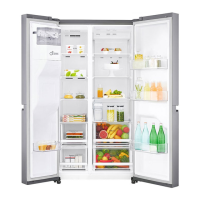Why is it hard to open my LG Refrigerator door?
- AAngela JenkinsSep 12, 2025
If you find it difficult to open the door of your LG Refrigerator, try again in a few minutes to allow the internal pressure to stabilize, especially if you just closed it.

Why is it hard to open my LG Refrigerator door?
If you find it difficult to open the door of your LG Refrigerator, try again in a few minutes to allow the internal pressure to stabilize, especially if you just closed it.
Why is the side of my LG Refrigerator warm?
If the side or front of your LG Refrigerator feels warm, it's due to anti-condensation pipes, which help reduce condensation around the door area. This is normal, especially after installation or during summer.
Why is my LG GSL481PZXZ Refrigerator vibrating?
If your LG Refrigerator is vibrating, ensure that the sides and back do not make any contact with any wall or cabinet. Normal vibrations can cause audible sounds if the appliance is touching other surfaces.
| Child lock | Yes |
|---|---|
| Product color | Stainless steel |
| Product design | American door |
| Custom panel-ready | No |
| Appliance placement | Freestanding |
| Connected load | - W |
| Energy efficiency scale | A to G |
| Annual energy consumption | 376 kWh |
| Lamp type | LED |
| Fridge net capacity | 405 L |
| Number of vegetable drawers | 2 |
| Fridge number of shelves/baskets | 4 |
| Star rating | 4* |
| Freezer position | Side-placed |
| Freezing capacity | 12 kg/24h |
| Freezer net capacity | 196 L |
| Freezer door balconies | 1 |
| Storage time during power failure | 10 h |
| Noise level | 39 dB |
| Climate class | T |
| Water supply type | Water tank |
| Total net capacity | 601 L |
| Water tank capacity | 4 L |
| Minimum operating temperature | 16 °C |
| Package depth | 770 mm |
| Package width | 968 mm |
| Package height | 1891 mm |
| Package weight | 135000 g |
| Depth | 738 mm |
|---|---|
| Width | 912 mm |
| Height | 1790 mm |
| Weight | 124000 g |
Introduces symbols indicating risks and warnings for safe operation.
Provides critical safety guidelines to prevent serious injury or death.
Details hazards related to flammable materials and refrigerant.
Provides precautions for minor injury, malfunction, or damage.
Instructions for environmentally sound disposal of the appliance.
General preparation and considerations before installing the appliance.
Specifies required space and dimensions for proper installation.
Details the operational temperature range for the appliance based on climate class.
Lists and illustrates the accessories provided with the appliance.
Step-by-step guide for safely removing refrigerator and freezer doors.
Instructions for connecting the water supply to the appliance.
Procedures for levelling the appliance and aligning the doors for proper function.
Guidelines for connecting the appliance to the power supply after installation.
Instructions on how to safely move and relocate the appliance.
Covers initial use, energy saving, food storage, and alarms.
Details maximum freezing capacity, two-star compartment, and express freeze.
Describes exterior and interior features, including LED lamp and components.
Explains the control panel layout, buttons, and locking function.
How to use the ice and water dispenser, including tank filling and cleaning.
Details the operation, installation, and maintenance of the automatic icemaker.
Guides for using and managing Door-in-Door, drawers, shelves, and door baskets.
Covers general cleaning tips, interior, exterior, and condenser cover cleaning.
Guidelines and steps for replacing the water filter for optimal performance.
Addresses problems related to refrigeration and freezing performance.
Solutions for problems with ice production, dispensing, and water supply.
Explains causes and solutions for condensation and frost formation.
Troubleshooting for water leakage, taste, and supply problems.
Addresses problems with door closure, opening, door mullion, and interior lamp.
Identifies common appliance noises and vibrations and their causes/solutions.
